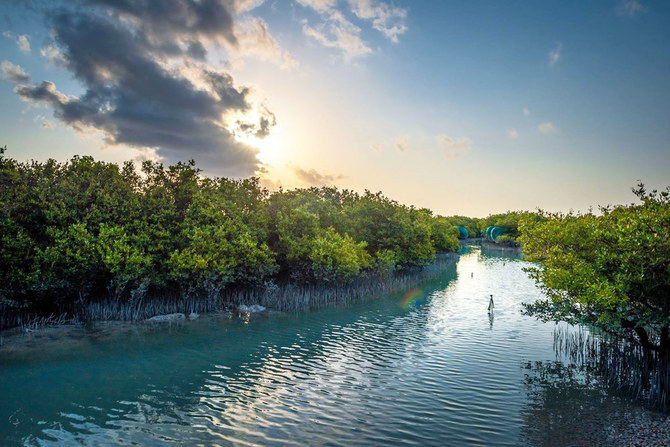
- ARAB NEWS
- 02 Jul 2025

Saturday, May 22 has been designated UN International Day for Biological Diversity with the aim of increasing understanding and awareness of biodiversity issues.
And Saudi Arabia, with its surprising diversity of wild animals and plants, will be celebrating the event which this year is running under the theme, “We’re part of the solution.”
The Kingdom boasts 499 species of bird, 117 different mammals, 107 kinds of reptile, 266 coral reef varieties, 1,230 types of fish, eight classifications of amphibian, and more than 2,400 flowering plant species.
Some of the most beautiful animals on Earth can be found in the country, including the resplendent Arabian sunbird with its iridescent green, blue, red, purple, and black feathers that sparkle in the sunlight.
Among other many fascinating creatures great and small is the Arabian babbler, a group-living bird that shows social behaviors as complex as chimpanzees or the most intricate Shakespearean drama.
Unfortunately, Saudi Arabia also contains some of the world’s most endangered animals, such as the Sarso Island racer, a snake discovered in the Farasan Islands off Jazan in 1964. It had never been seen before – and has never been seen since.
Around 70 percent of the Kingdom’s plant and animal species are on the decline, and around 33 percent have formally been listed as threatened with extinction.
Alarming statistics such as these can be daunting and discouraging. If so many species are decreasing in numbers, which ones should be helped first?
Globally, communities have tended to focus on saving large, charismatic, pretty, cute, and cuddly species but there has often been little scientific rationale behind the decisions.
The key message from UN International Day for Biological Diversity and Aramco is that everyone should be part of the solution to the biodiversity crisis. If we cannot protect our biological diversity, then who will?
Chris Boland
Saudi Aramco has been striving to protect the biodiversity of the land, seas, and coastlines the company operates in. The firm recently developed a scientific method for ranking the conservation priority of every animal species that lives in Saudi Arabia (not including marine species).
It scored each species out of 100 according to several factors, such as how endangered it was, how many individuals remained, whether numbers were increasing or decreasing, how much of the global population occurs in the country, and how unique it was.
This allowed the company to create a score sheet that ranked every species from the highest conservation priority to the lowest and is purely empirical.
By using the scientific scoring system, Aramco found that the highest conservation priority species in Saudi Arabia right now was a freshwater fish called the Arabian bream. This little fish was first discovered in 1983 but was not seen again until 2014 at Khaybar. It is critically endangered and only known to inhabit one small dam in the Kingdom.
The next highest conservation priority animal was the Asir magpie. Perhaps only 100 pairs of the bird remain, all of which are confined to a few tiny patches of juniper forest in the Asir mountains of Saudi Arabia.
Most of the top 20 highest conservation priority species were found to be small freshwater fish, reptiles, or birds that few people had heard of.
Most are not beautiful, or iconic. But that does not mean people should care any less about them. Indeed, the fact that these animals are so little-known is another reason why Aramco is ensuring it treads very carefully wherever it operates.
The company has recently developed a corporate biodiversity protection policy requiring all new projects to have a net positive impact on biodiversity.
Through the initiative, it seeks to protect biodiversity by reserving high-quality habitat: To date, Aramco has designated 10 biodiversity protection areas on company land covering 977 square kilometers and helped to protect more than 500 species of plants and animals.
When undertaking new projects, it also conducts thorough biodiversity surveys before commencing site preparation, to protect native species.
And it works hard to restore degraded habitat. For example, the firm has planted millions of mangrove trees at key sites along the coasts to restore vitally important habitats, and it has reintroduced Arabian oryx, gazelle, and red-necked ostrich into its vast Shaybah Wildlife Sanctuary in the Rub’ Al-Khali desert.
The world is confronted by a global biodiversity crisis and the big question is how can people help?
In Saudi Arabia, the protection of native plants has been identified as a priority. Individuals are being encouraged to avoid driving over desert vegetation and urged not to collect too much wood. A small plant only 50 cm high may be 40 or 60 years old and if killed could take decades to be replaced.
Planting native trees, stopping littering and the hunting of wild animals, and eating less meat are just some actions that can help reduce the human footprint, and give more room for nature to exist.
The key message from UN International Day for Biological Diversity and Aramco is that everyone should be part of the solution to the biodiversity crisis. If we cannot protect our biological diversity, then who will?
• Chris Boland is an environmental specialist at Saudi Aramco.